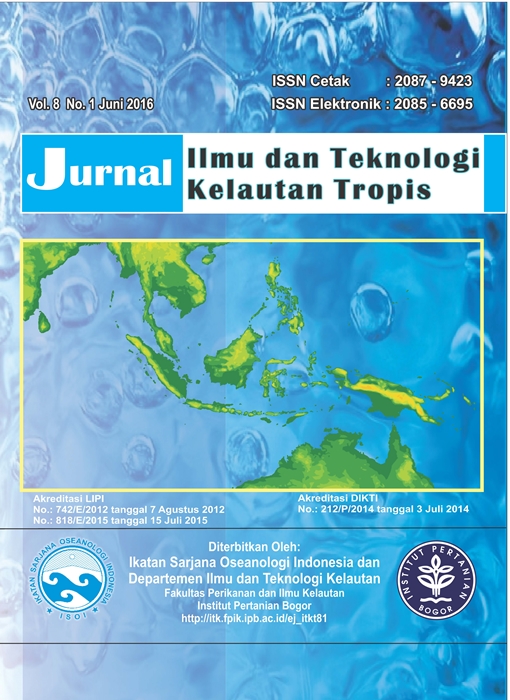PLANKTON COMMUNITY STRUCTURE OF TRADITIONAL AND INTENSIVE BRACKISHWATER PONDS IN PROBOLINGGO REGENCY, EAST JAVA PROVINCE
Abstract
This experiment aimed to determine the plankton community structure in intensive and traditional ponds of Probolinggo Regency, East Java Province. Plankton collected with plankton net size of 60 μm and preserved with lugol 1%. Water qualities such as temperature, transparancy, salinity, dis-solved oxygen, pH, total organic matter, NO2-N, NO3-N, NH3-N, PO4-P, and total suspended solids were measured and analysed in this study. Planktons were identified using microscopy. Cells were counted using cell counting method. The results showed that in intensive pond we found 16 species of phytoplankton and 7 species of zooplankton with abundance 570-1.808 ind./L, while in traditional ponds, we found 10 species of phytoplankton and 3 species of zooplankton with abundance 134-776 ind./L. The dominant species of phytoplankton in the intensive and traditional ponds were Navicula sp andNitzschia sp, each of Bacillariophyceae class with abundance of 423 ind./L and 198 ind./L, res-pectively. Zooplankton species in intensive pond was copepod sp, while in traditional one was Oitho-na sp, each of Crustaceae class with abundance of 66 ind./L and 37 ind./L, respectively. Diversity and abundance of plankton in intensive pond was higher than in the traditional ponds. The water quality in intensive pond was optimal so that the response to the absorption of N and P inorganic by phyto-plankton was quicker and more effective than in traditional pond producing an increase in plankton communities. The increase value of NO3-N and total suspended solids in intensive pond caused the in-crease abundance of Navicula sp. The high value of NH3-N caused the abundance of Navicula sp to decline. The high values of dissolved oxygen, pH, total suspended solid, and NH3-N in traditional pond can decrease the Nitzschia sp abundance.
Keywords: plankton communities, intensive and traditional ponds, Probolinggo, East Java
Authors
This work is licensed under a Creative Commons Attribution 4.0 International License.
Jurnal Ilmu dan Teknologi Kelautan Tropis i is an open-access journal, meaning that all content is freely available without charge to the user or their institution. Users are allowed to read, download, copy, distribute, print, search, or link to the full texts of the articles in this journal without needing to request prior permission from the publisher or the author.
All articles published by Jurnal Ilmu dan Teknologi Kelautan Tropis are licensed under the Creative Commons Attribution 4.0 International License. This allows for unrestricted use, distribution, and reproduction in any medium, provided proper credit is given to the original authors.
Authors submitting manuscripts should understand and agree that the copyright of published manuscripts is retained by the authors. Copyright encompasses the exclusive rights of authors to reproduce, distribute, and sell any part of the journal articles in all forms and media. Reproduction of any part of this journal, its storage in databases, and its transmission by any form or media is allowed without written permission from Jurnal Ilmu dan Teknologi Kelautan Tropis.


